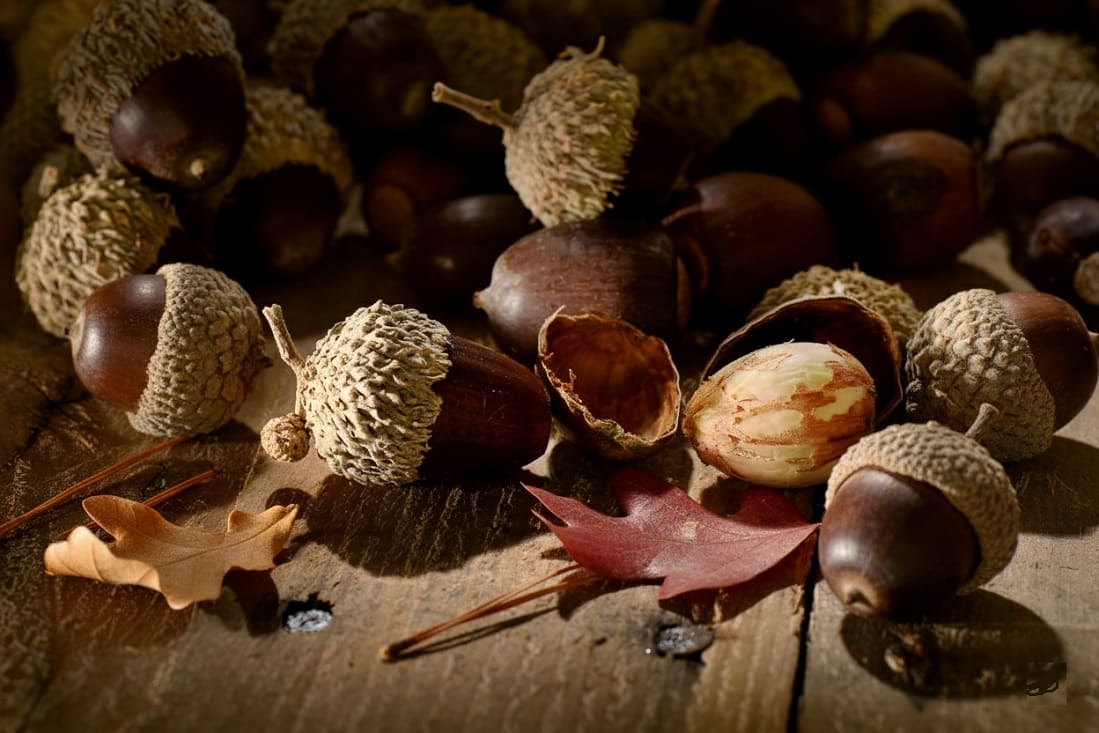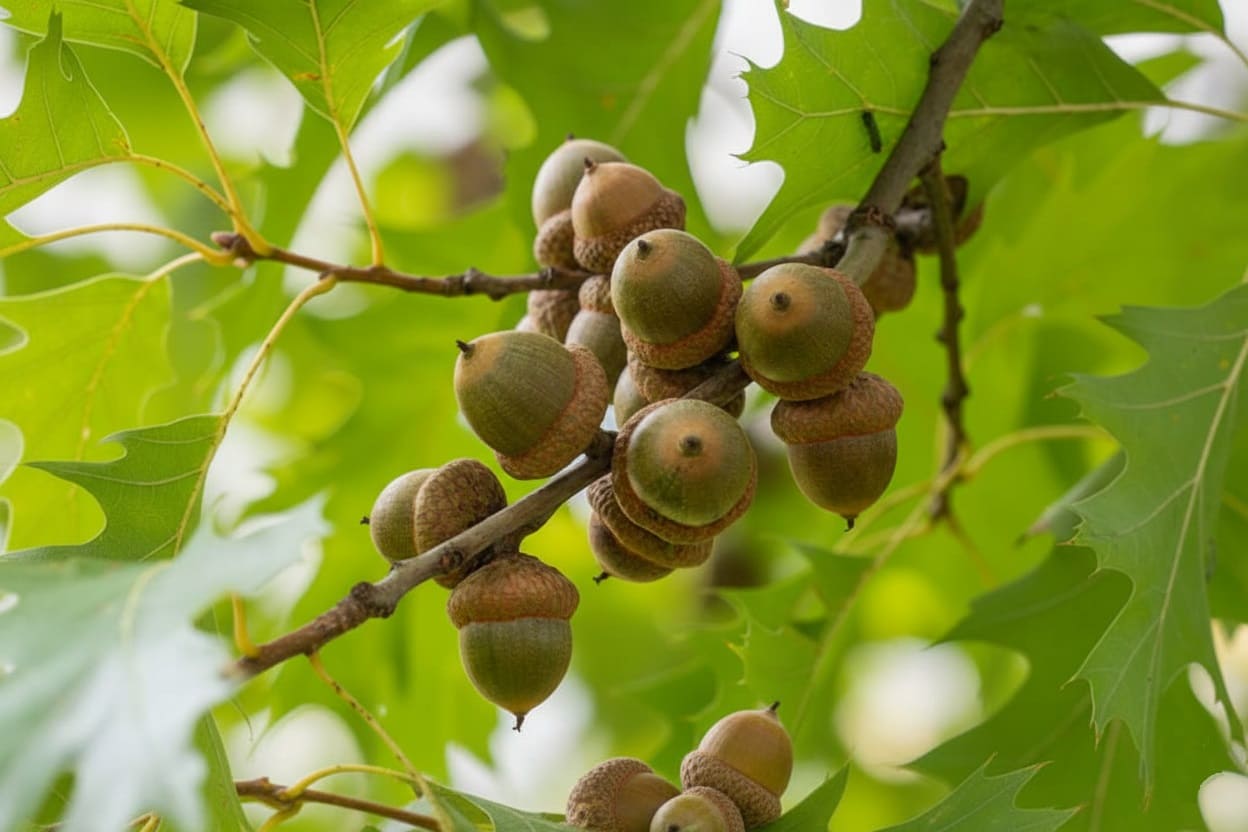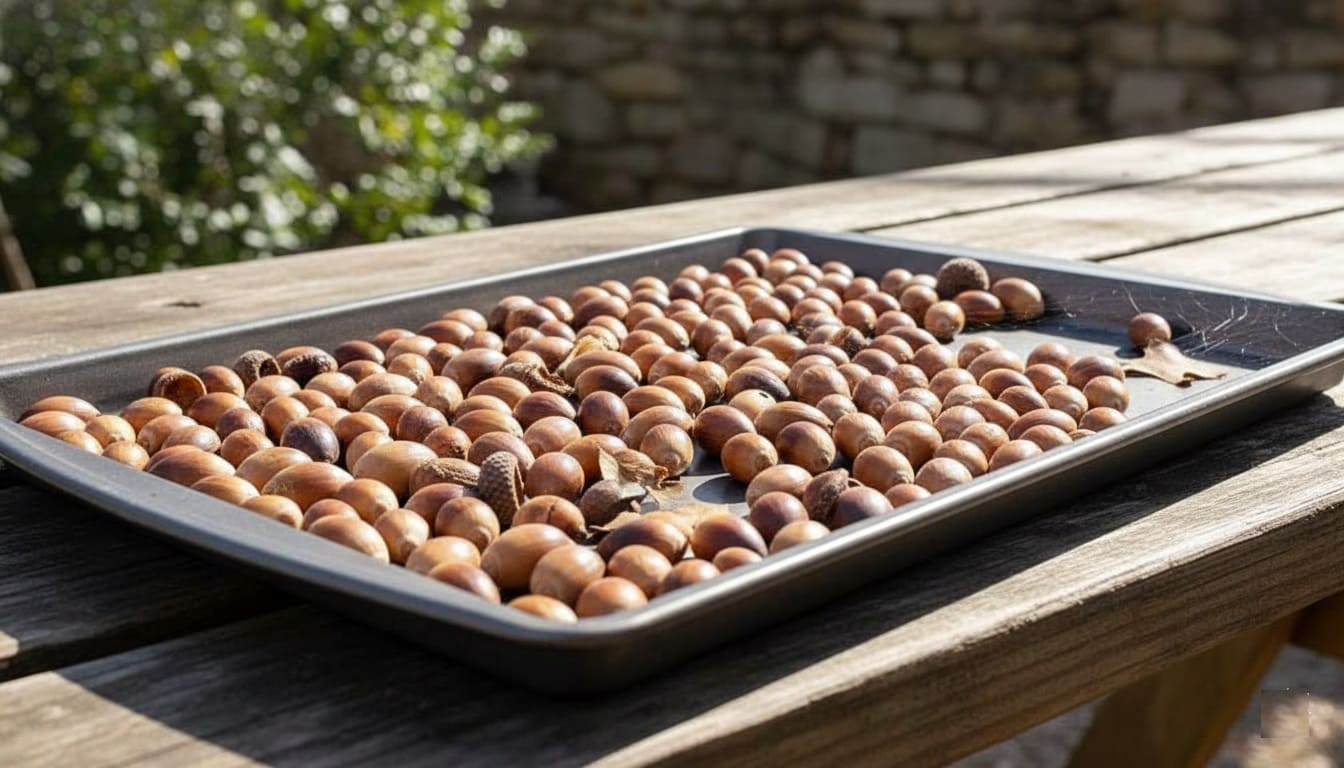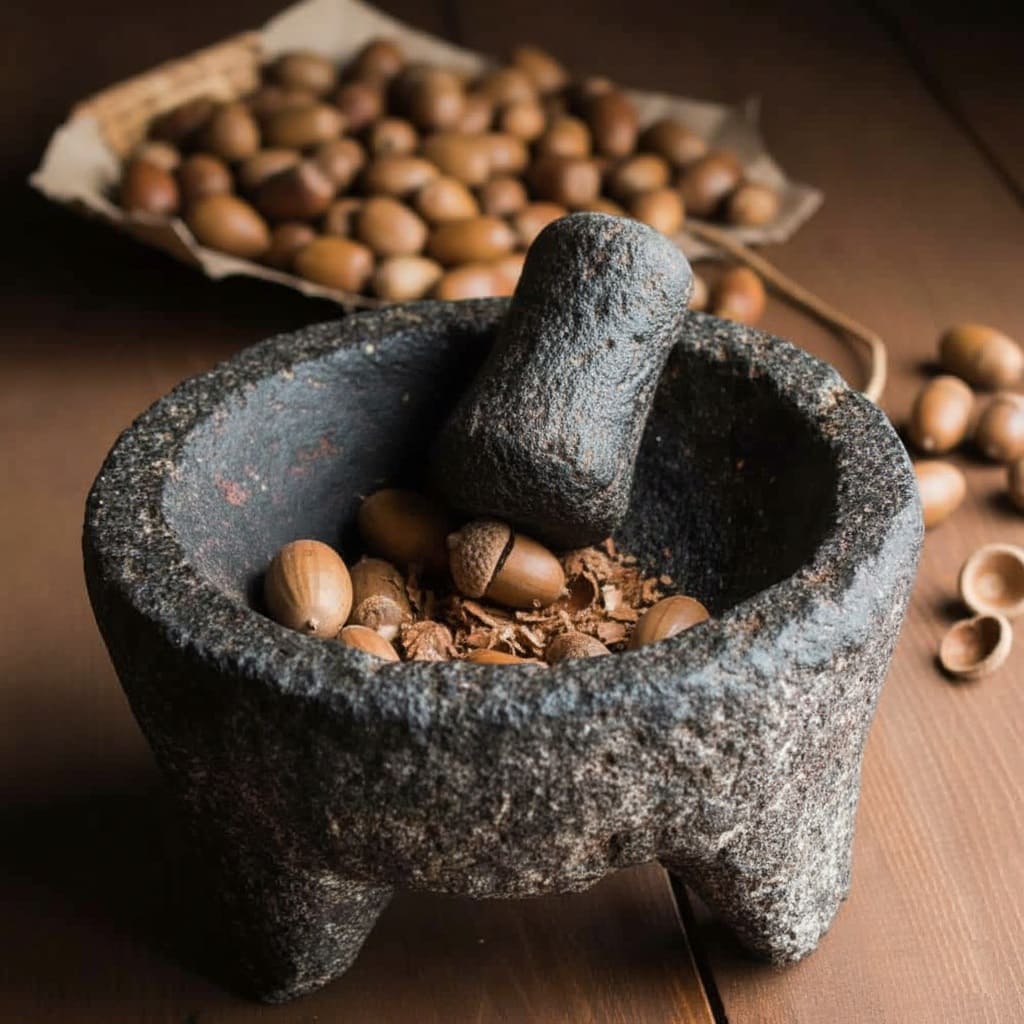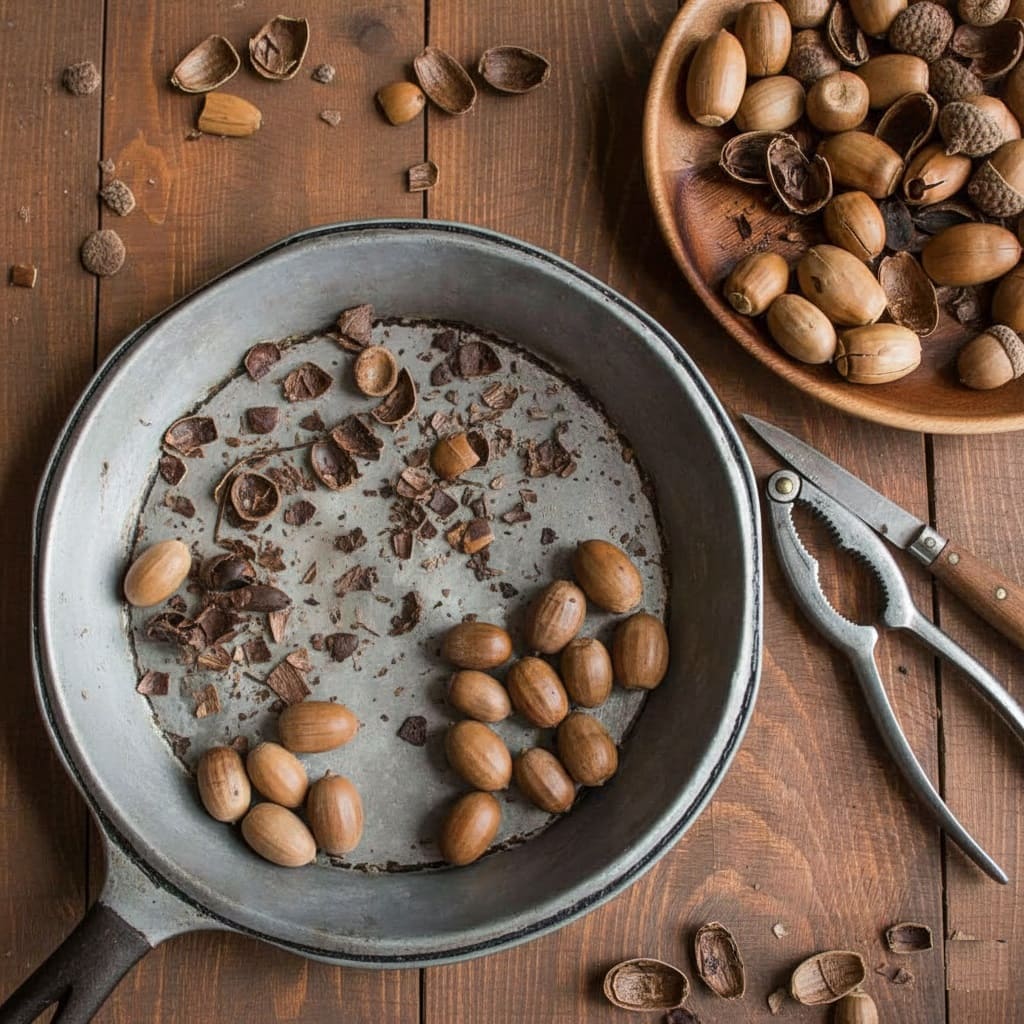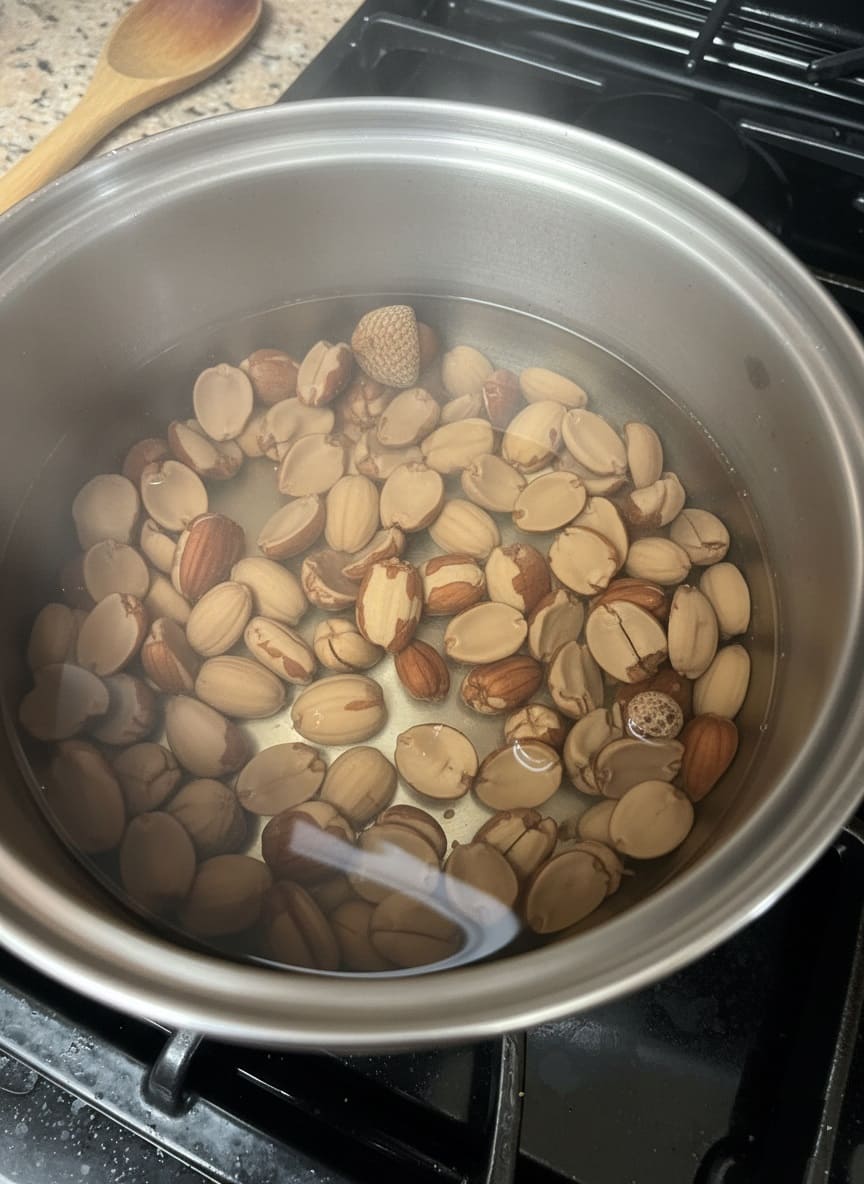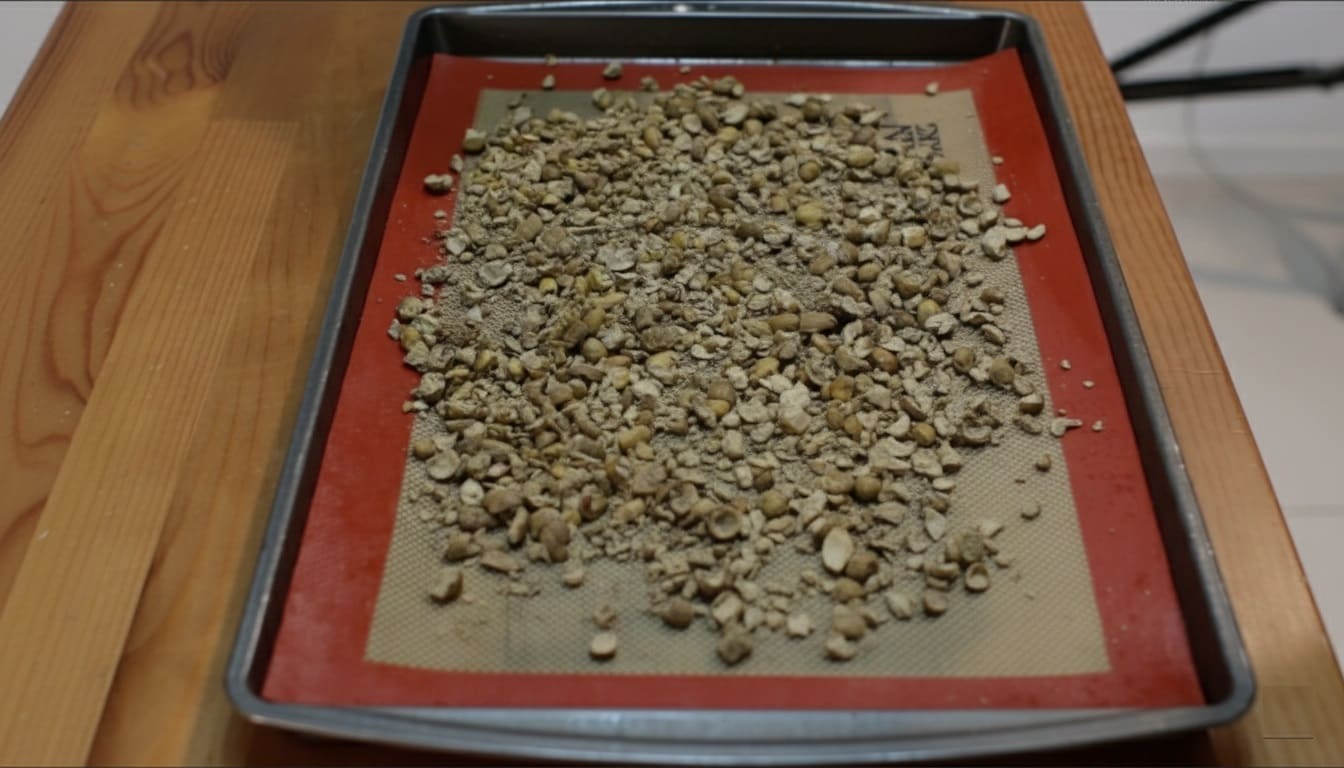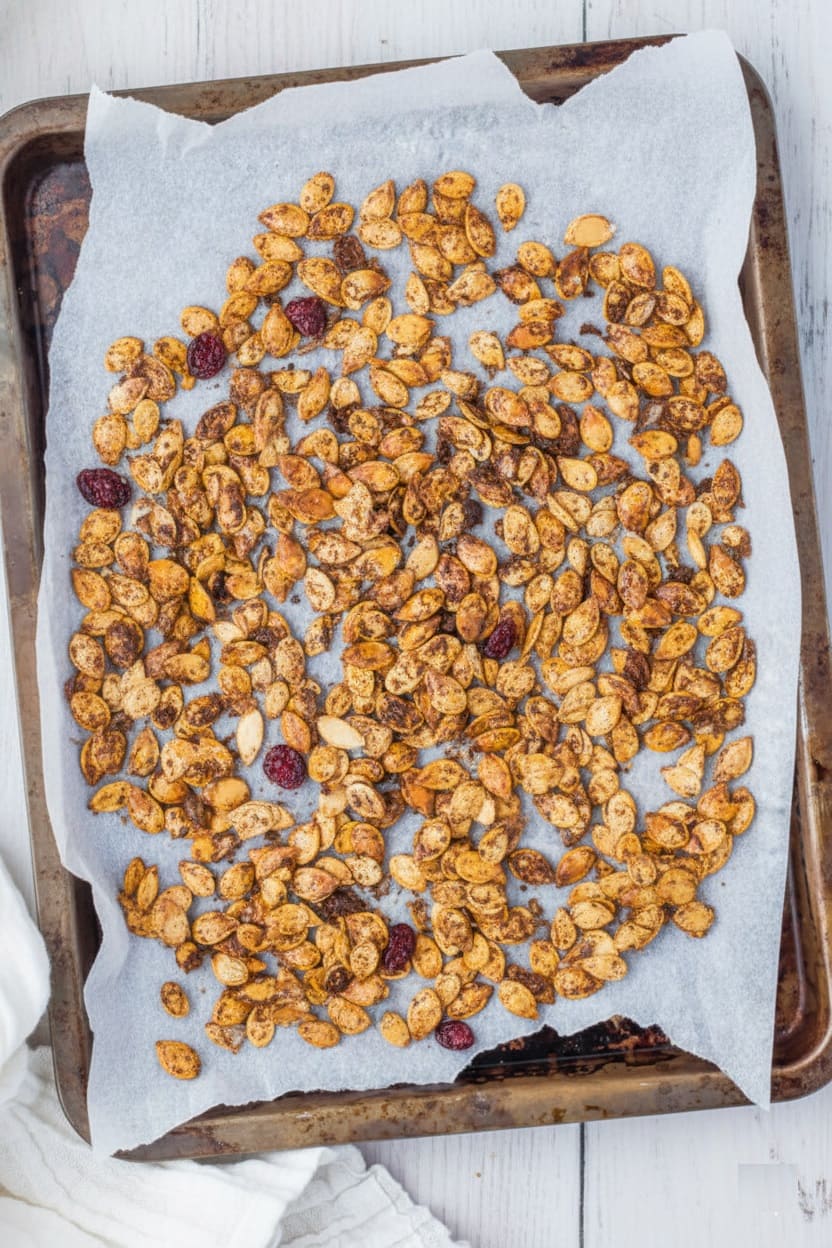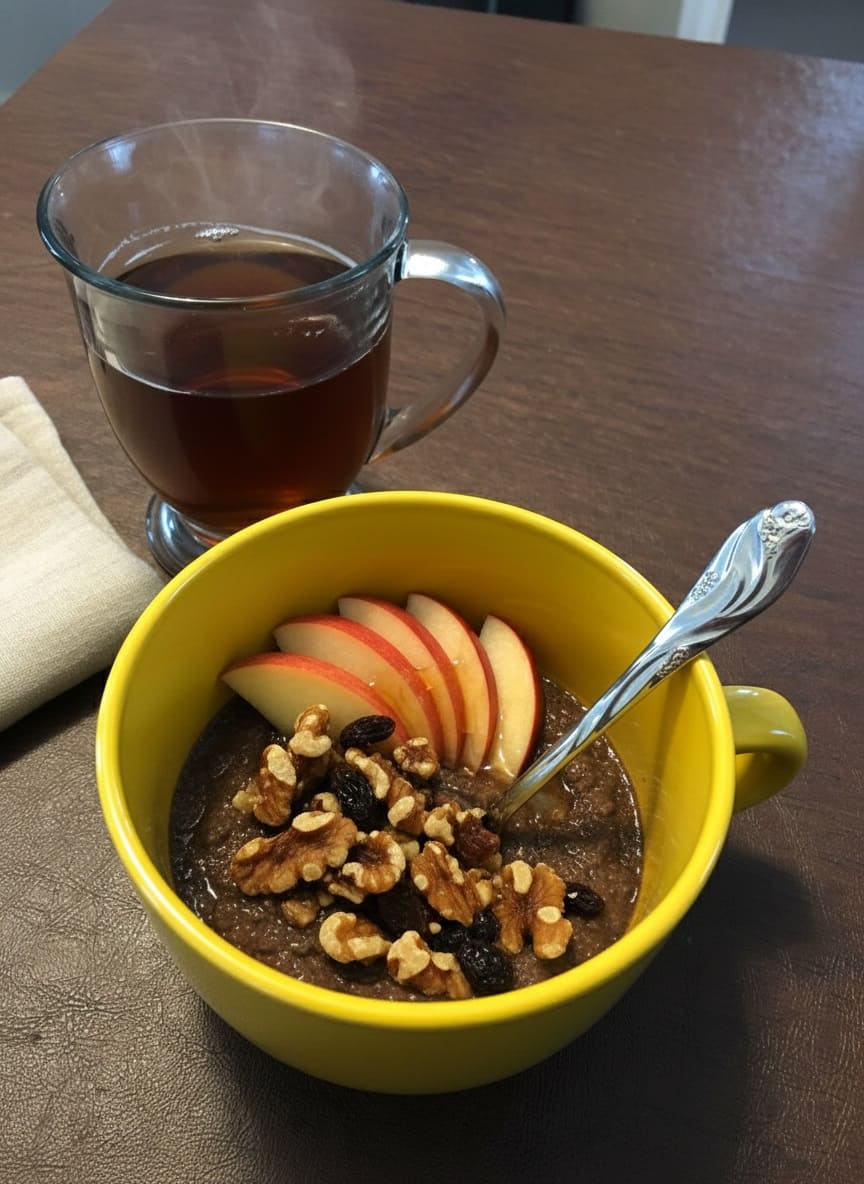Have you ever crunched across a carpet of acorns on an autumn walk and thought, “There’s got to be something we can do with all these”?
You’re absolutely right. While most of us see acorns as squirrel snacks or yard debris, these humble nuts once sustained entire civilizations—and they can nourish you too.
In this guide, you’ll discover why acorns deserve a place in your kitchen, how to safely transform them from bitter to delicious, and creative ways to use them in everyday cooking. By the end, you’ll never look at an oak tree the same way again.
The Forgotten Superfood Growing in Your Backyard
Acorns aren’t just survival food—they’re a nutritional powerhouse that has fed humans for millennia.
- Ancient Greeks considered them “food for invincible men.”
- Native Californian tribes built their entire food system around oak harvests, creating a stable society without agriculture.
- During World War II, Japanese schoolchildren collected over one million tons of acorns to help feed their nation.
So what happened? Why did this abundant, nutritious food nearly disappear from modern tables? The answer lies in agricultural evolution and the convenience of cultivated grains.
But here’s the remarkable thing: oak trees still produce this free, sustainable food every single autumn, with virtually no human effort required. A mature oak can drop 2,000 pounds of acorns in a good year—plenty for both you and the wildlife.
The Bitter Truth: Why You Can’t Just Pop Them in Your Mouth
Let’s address the elephant (or squirrel) in the room: raw acorns taste absolutely terrible. That mouth-puckering bitterness you experience if you bite into one? That’s tannins—the same compounds that give red wine its dry finish, but in much higher concentrations.
Here’s the deal: tannins aren’t just unpleasant; in large quantities, they can be harmful to your digestive system and kidneys.
But here’s the good news: tannins are completely water-soluble. Humans figured this out thousands of years ago, and the processing methods they developed are surprisingly simple.
Think of it this way: Acorns are like olives. Fresh off the tree, both are inedible. But with proper processing, they become culinary treasures. The transformation just takes a little knowledge and patience.
👉 Learn about Corn Smut: From Garden Foe to Gourmet Delicacy
Nutritional Goldmine: What’s Actually Inside an Acorn?
Once properly processed, acorns pack a serious nutritional punch. A single pound of shelled acorns provides about 1,265 calories. Here’s what you’re getting in a 100-gram serving:
- Calories: 387-500 (depending on species)
- Carbohydrates: 40-50%
- Fats: 24-34% (mostly heart-healthy unsaturated fats, similar to olive oil)
- Protein: 6-9% (complete protein with all essential amino acids)
- Fiber: Significant amounts
- Vitamins: Rich in B vitamins, especially B6, plus vitamins A, C, and E
- Minerals: High in manganese, potassium, calcium, iron, copper, and zinc
The fat profile is particularly impressive—acorn oil resembles olive oil in its composition, containing predominantly beneficial monounsaturated and polyunsaturated fatty acids.
Plus, acorns are naturally gluten-free, making them an excellent option for those with celiac disease or gluten sensitivity.
Best of all? Acorns are actually lower in calories than most other nuts (compare 500 calories per 100g for acorns versus 600-700 for most tree nuts), while providing similar nutritional benefits.
Your Acorn Hunting Guide: When and What to Collect
Timing Is Everything
Acorn season typically runs from September through November, though timing varies by location and oak species. Here’s the secret experienced foragers know: there are two drops, and you want the second one.
Oak trees cleverly abort damaged, insect-infested, or underdeveloped acorns early in the season. This first drop is mostly duds. Wait for the second major drop—usually mid-to-late October—when the tree releases its good acorns.
You’ll know it’s happening when you hear the constant patter of nuts hitting the ground during windy days.
Spotting the Good Ones
Signs of a quality acorn:
- Brown and fully mature (not green)
- Cap has naturally separated or comes off easily
- Firm, hard shell with no cracks
- No visible holes (signs of weevil damage)
- Smooth, clean disc where the cap attaches
- Feels heavy for its size
Red flags to avoid:
- Green or unripe (unless you plan to dry them further)
- Caps still firmly attached
- Small holes in the shell (weevil exit points)
- Dark spots, discoloration, or mold
- Damaged or broken disc at the base
- Lightweight or rattles when shaken
Pro tip: When you get home, do the float test—place all acorns in a bucket of water. Toss the floaters (they’re bad or infested); keep the sinkers. This simple test can save you hours of processing time.
Decoding Oak Species: A Shortcut to Better-Tasting Acorns
Not all acorns are created equal. Understanding the difference between oak groups can save you significant processing time and lead to better-tasting results.
White Oak Group (The Mild-Mannered Nuts)
Identification:
- Leaves with rounded, smooth lobes (no pointy tips)
- Acorn caps that look fuzzy or shaggy
- Smooth interior of the cap
- Mature and drop in one season
- Begin sprouting almost immediately after falling
- Taste profile: Mild, slightly sweet, require minimal leaching
- Best species: Swamp white oak, Oregon white oak, burr oak, live oak
Red/Black Oak Group (The Bitter Bunch)
Identification:
- Leaves with pointed, bristle-tipped lobes
- Acorn caps with distinct scales
- Fuzzy hair inside the cap
- Take two years to mature
- Don’t sprout until spring
- Taste profile: Very bitter, require extensive leaching
- Processing difference: Red and black oak acorns contain significantly more tannins and may take two to three times longer to leach than white oak acorns.
- Here’s your rule of thumb: The larger the cap relative to the nut, the more bitter the acorn will be. Small caps generally mean milder nuts.
The Complete Processing Guide: From Shell to Table
Processing acorns isn’t difficult, but it does take time. Think of it as a weekend project or something you can do in stages over several weeks. Here’s how to transform those bitter nuts into delicious, versatile ingredients.
Step 1: Drying (Optional but Recommended)
Drying serves multiple purposes: it makes shells easier to crack, the nutmeat easier to extract, and extends storage life dramatically.
How to dry:
- Spread acorns in a single layer on baking sheets, screens, or shallow trays
- Place in direct sunlight, a warm attic, near a wood stove, or in an oven at 150°F for 20-30 minutes
- Time needed: 2-5 days in sun, or a few hours with heat
- They’re done when shells crack easily and nutmeats are hard
Fully dried acorns can be stored in their shells for years in a cool, dry place.
👉 Here’s How to Dehydrate Apples at Home: Easy Steps for Perfect Results
Step 2: Cracking and Shelling
This is often cited as the most tedious step, but there are techniques to make it easier.
For small batches (hand-cracking):
- Use a nutcracker, hammer, or pliers
- Strike the pointy end while the flat end rests on a firm surface
- Pick out the nutmeat by hand
For larger batches (mass-cracking):
- Spread 20-30 acorns on a hard, flat surface
- Cover with an old towel to contain flying pieces
- Smash them all at once with a heavy, flat object (cinder block, wide board, large flat rock)
- Separate shells from nutmeats by hand, or use the water float method
For serious harvesters:
- Consider investing in a Davebilt nutcracker (~$200)
- Can process up to 20 gallons per hour
- Hand-crank operation, built to last decades
- Works well for multiple nut types
Don’t forget: Remove the papery brown skin (testa) covering the nutmeat. It’s especially high in tannins. Much of it will come off during the float test or with gentle rubbing.
👉 Discover Creative Uses for Pistachio Shells in Your Garden & Home
Step 3: Grinding (Before or After Leaching)
Whether you grind before or after leaching depends on your chosen leaching method:
- For cold leaching: Grind first. The finer the grind, the faster the leaching.
- For hot leaching: Keep in large pieces or halves, grind after if needed.
Grinding options:
- Food processor or blender (modern and fast)
- Coffee grinder (for small batches or final grinding)
- Grain mill (traditional, produces consistent texture)
- Mortar and pestle (extremely labor-intensive, but authentic)
Step 4: Leaching the Tannins (The Most Critical Step)
This is where the magic happens. There are two main approaches, each with distinct advantages:
Cold Water Leaching (Best for Flour and Baking)
Why choose this method:
- Preserves the starch structure, allowing acorn flour to bind when cooked
- Retains more nutrients
- Results in flour that can be used independently in recipes
- Maintains lighter color
Process:
- Place ground acorn meal in a large jar or container
- Add cold water at a ratio of at least 3:1 water to meal (more is better)
- Stir well and refrigerate
- Once or twice daily, let the meal settle to the bottom
- Pour off the brown water (save it—more on that later!)
- Add fresh cold water
- Repeat for 5-14 days (varies by species)
- Taste-test regularly—when there’s no bitterness, you’re done
Time-saving variation: Use a mesh bag or multiple layers of cheesecloth under running tap water. Massage and rinse continuously for 20-30 minutes. This is faster but results in some nutrient loss.
Super lazy method: Clean your toilet tank, place acorns in a mesh bag inside, and let every flush do the work for you. Seriously—it works!
Hot Water Leaching (Best for Roasted Nuts and Quick Use)
Why choose this method:
- Much faster (hours instead of days)
- Good for immediate consumption
- Works well if you plan to roast the acorns whole
Process:
- Bring two large pots of water to a boil
- Place shelled acorn pieces in one pot
- Boil for 15-20 minutes until water turns dark brown
- Strain the acorns using a fine-mesh strainer
- Immediately place hot acorns in the second pot of boiling water
- While they boil, refill and reheat the first pot
- Continue rotating between pots 3-6 times until water runs relatively clear
- Taste—when not bitter, you’re finished
Critical rules:
- Never place boiled acorns in cold water (this binds the tannins permanently)
- Never start acorns in cold water and bring to a boil (same problem)
- Always move from boiling water to boiling water
The trade-off: Hot leaching cooks the starch, meaning the resulting flour won’t bind or thicken when cooked. You’ll need to mix it with wheat flour or another binder for baking. Hot leaching also removes more oils and nutrients.
Step 5: Drying Your Processed Acorns
After leaching, you have two options:
Use immediately while wet: Great for porridges, soups, or recipes with plenty of liquid.
Dry for storage:
- Spread leached acorn meal thinly on baking sheets or dehydrator trays
- Dry in a dehydrator, in an oven at 150°F, or in direct sunlight
- Stir occasionally to ensure even drying
- Time needed: 2-4 hours with heat, 1-2 days in sun
- Meal is ready when completely dry and crumbly
Final grinding: For super-fine flour, run dried meal through a coffee grinder or food processor, then sift. Store in airtight containers in the refrigerator (up to 3 months) or freezer (up to 1 year).
Putting Acorns to Work: Delicious Ways to Use Your Harvest
Now for the fun part! Processed acorns are incredibly versatile. They have a mild, slightly sweet, nutty flavor reminiscent of chestnuts with earthy undertones.
Acorn Flour in Baking
Cold-leached acorn flour can replace up to 50% of wheat flour in most recipes. It adds a beautiful brown color, subtle nuttiness, and extra nutrition.
Try it in:
- Pancakes and waffles
- Muffins and quick breads
- Cookies (especially peanut butter cookies)
- Pie crusts and pastries
- Pasta dough
- Tortillas and flatbreads
- Cornbread (substitute for some of the cornmeal)
Pro tip: Since acorn flour has no gluten, use it alongside wheat flour for structure, or add eggs and binders for gluten-free baking.
Roasted Acorn Snacks
Hot-leached acorn pieces make excellent roasted nuts:
- Spread damp acorn chunks on a baking sheet
- Sprinkle with salt (or try garlic salt, smoked paprika, or rosemary)
- Roast at 375°F for 15-20 minutes
- Cool and enjoy like roasted chestnuts
Sweet variation: Toss roasted acorns in honey, maple syrup, or cinnamon sugar.
Acorn Porridge (Traditional Wi-wish)
This is how many Native American cultures enjoyed acorns daily:
- Mix 1 cup coarse acorn meal with 2 cups water
- Simmer, stirring frequently, until thick and creamy (10-15 minutes)
- Season with salt, honey, maple syrup, or cinnamon
- Top with dried fruit, nuts, or fresh berries
It’s naturally gluten-free, filling, and perfect for cold mornings.
Acorn Coffee (Caffeine-Free)
A warming beverage that tastes nothing like coffee but has its own unique appeal:
- Roast leached acorns at 400°F for 30 minutes until dark brown (not burned)
- Cool completely
- Grind into a fine powder
- Brew like coffee: 1-2 tablespoons per cup of boiling water
- Steep 5-10 minutes, strain, and enjoy
Add cream and sweetener as desired.
Creative Culinary Uses
In savory dishes:
- Add to soups and stews (like chickpeas or potatoes)
- Make acorn “meatballs” or veggie burgers
- Use in grain bowls and salads
- Substitute for breadcrumbs in meatloaf or stuffing
- Create acorn hummus or spreads
Sweet treats:
- Acorn brittle (like peanut brittle)
- Acorn butter (like almond or peanut butter)
- Acorn cookies and brownies
- Korean-style acorn jelly (dotori-muk)
👉 Related post: What Is Hominy? Nutrition, Cooking Tips & Easy Recipes
Recipe: Rustic Acorn Pancakes
Serves: 4 | Prep time: 10 minutes | Cook time: 15 minutes
Ingredients:
- 1 cup cold-leached acorn flour
- 1 cup whole wheat or all-purpose flour
- 2 teaspoons baking powder
- ½ teaspoon salt
- 2 eggs (or flax eggs for vegan)
- 1¾ cups milk (dairy or plant-based)
- 2 tablespoons maple syrup or honey
- 2 tablespoons melted butter or oil
- 1 teaspoon vanilla extract
Instructions:
- Whisk together both flours, baking powder, and salt in a large bowl.
- In a separate bowl, beat eggs, then add milk, maple syrup, melted butter, and vanilla.
- Pour wet ingredients into dry ingredients and stir gently until just combined. Don’t overmix—some lumps are fine.
- If batter is too thick, add milk one tablespoon at a time. It should pour but not be runny.
- Heat a griddle or skillet over medium heat and lightly grease.
- Pour ¼ cup batter per pancake onto the hot griddle.
- Cook until bubbles form on the surface and edges look set (2-3 minutes).
- Flip and cook another 1-2 minutes until golden brown.
- Serve hot with butter and maple syrup, or try with fresh berries and acorn butter!
Tip: These freeze beautifully. Make a double batch and reheat for quick weekday breakfasts.
Don’t Waste That Brown Water!
Remember that tannic water you’ve been pouring off during leaching? It has surprising uses:
For first aid:
- Apply as a wash for poison ivy, rashes, or skin irritations
- Use as a gargle for sore throats
- Compress for minor burns and cuts
- External treatment for hemorrhoids
For home and garden:
- Natural fabric dye (creates beautiful tan and brown shades)
- Eco-friendly laundry detergent (2 cups per load)
- Leather tanning projects
- Natural wood stain
👉 Learn about Banana Peel Fertilizer: Truth vs. Myths About This Popular Garden Hack
Just remember: Don’t drink it! The tannins that are being removed are the very reason it’s useful for these external applications.
Common Mistakes and How to Avoid Them
- Mistake #1: Collecting too early
The first acorn drop is mostly bad nuts. Wait for the second major drop in mid-to-late October for the best quality.
- Mistake #2: Under-leaching
If your finished acorns taste even slightly bitter, they need more leaching. That bitterness means tannins remain, which can cause stomach upset. Always taste-test before considering them done.
- Mistake #3: Mixing cold and hot water during leaching
Switching between cold and hot water, or putting boiled acorns into cold water, can lock tannins into the starch. Stick with one method all the way through.
- Mistake #4: Not drying thoroughly after leaching
Wet acorn meal molds incredibly quickly. Make absolutely sure it’s bone-dry before storing, or keep it refrigerated and use within a few days.
- Mistake #5: Storing improperly
Acorn flour is high in oils and will go rancid at room temperature. Always store in airtight containers in the refrigerator or freezer.
- Mistake #6: Expecting it to taste like commercial flour
Acorns have their own unique flavor. They won’t taste like wheat flour or almond flour. Embrace the earthy, nutty taste rather than fighting it.
Frequently Asked Questions
- Q: How long does the entire processing take?
A: It depends on your method. Hot leaching can be done in a few hours, while cold leaching takes 5-14 days (mostly passive time). Add a few hours for sorting, shelling, and drying. Plan for at least one full day of active work spread over 1-2 weeks.
- Q: Are acorn weevil grubs harmful if I accidentally eat one?
A: No, they’re actually edible and high in protein! Many foragers cook them in butter like a tiny steak. That said, most people prefer to avoid them, which is fine—just check your acorns carefully during shelling.
- Q: Can I eat acorns if I have a tree nut allergy?
A: Acorns are tree nuts, so there’s a risk of allergic reaction. If you have any tree nut allergies, consult your doctor before trying acorns. Better safe than sorry.
- Q: How much usable acorn meat will I get?
A: Expect about a 2:1 ratio. Two gallons of in-shell acorns yield roughly one gallon of nutmeat. Factor in discarding bad nuts, and you might get closer to 1.5:1 in reality.
- Q: Why do my acorns still taste bitter after leaching?
A: Keep leaching! Different species have vastly different tannin levels. Red and black oak acorns can take significantly longer than white oak acorns. Trust your taste buds over any suggested timeline.
👉 Here’s How to Get Rid of Bitter Taste in Cucumbers With 4 Simple Techniques
- Q: Can I feed acorns to my pets or livestock?
A: Raw acorns are toxic to horses, cattle, sheep, goats, and dogs due to gallotannins. However, ducks, chickens, and pigs can eat them. Goats can handle small amounts. Always research your specific animal before offering acorns.
- Q: What if I don’t have oak trees nearby?
A: Check parks, nature preserves, school grounds, and street trees. Oak trees are incredibly common in most temperate regions. Always ensure you have permission to collect, and avoid areas that have been sprayed with pesticides.
- Q: Do acorns have an expiration date?
A: Dried, unshelled acorns can last several years in cool, dry storage. Once shelled and processed, acorn flour keeps 2-3 months in the fridge or up to a year in the freezer. Always smell before using—rancid acorns smell like old crayons or paint.
The Real Value: Connection Over Convenience
Let’s be honest—acorns aren’t convenient. In a world of instant gratification, spending hours processing nuts that require weeks of leaching seems absurd when you can buy almond flour with zero effort.
But consider what you gain beyond the flour:
- Connection to ancestral foodways practiced for millennia.
- Sustainability without agriculture’s environmental costs.
- Complete nutrition from a truly local source. Practical skills that increase food security.
- And perhaps most valuably, an abundance mindset—once you see acorns as food, autumn transforms from cleanup season to harvest season.
Start small. Collect a few pounds. Shell them during a weekend movie marathon. Try cold-leaching. Make one batch of pancakes. See how it feels.
You might discover that the process itself—meditative, grounding, connecting—nourishes as much as the food you create.
The squirrels won’t miss a few pounds. And you might just find yourself joining modern foragers bringing this ancient food back where it belongs: on our tables and in our food story.
Your acorns are waiting. Grab a bucket and start your autumn harvest.
Have you processed acorns? Share your experience, tips, or recipe successes in the comments below!
